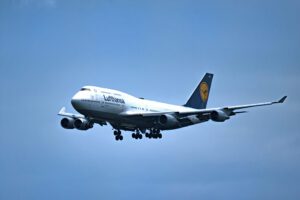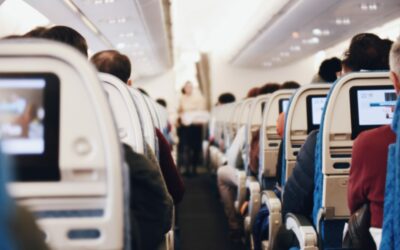There are jet lag myths and reality. I use my long haul flight experience to end long flight jet lag fast.

Long haul flight landing at Dulles International Airport. Copyright © 2022 NSL Photography, All Rights Reserved.
On our recent trip to Australia and New Zealand, we learned how to end long flight jet lag fast. My wife and I flew west from Los Angeles to Sydney. That flight took more than 15 hours, crossed six time zones, changed from standard to daylight time and crossed the International Date Line. The day before, we flew across three time zones over the U.S. from the east coast. So, that’s the equivalent of 10 time zones in a little more than 24 hours.
We flew east from Auckland, New Zealand, to Los Angeles on the way back. The flight took 12 hours and crossed four time zones, the International Date Line and a change back to standard time. Early the following day we flew across another three time zones. For most people, flying east when you’re losing time the whole way is more complicated than going west when you’re gaining time. It was for us, too.
When your flights last from 12 to more than 15 hours, you’re going to encounter jet lag.
When you fly those distances, you’ve got to minimize jet lag for your well-being. We learned a secret. End long flight jet lag fast.
Jet lag can be measured by the number of time zones you cross during your flight. The International Date Line doesn’t come into play very much, except to your psyche, which makes it worse for some. Moving between Standard Time and Daylight Time makes a difference. It’s like crossing another time zone. Everything adds up for the long distance air traveler to pillage one’s circadian rhythm.
The bigger the time zone difference and the light-dark timing of your arrival, the more your body is desynchronized and the longer it will take to resynchronize with your destination time zone and not be exhausted while you tour locations that you’ve been waiting to see your whole life.
Jet lag doesn’t discriminate between infrequent leisure travelers and “road warriors.”

Jet lag hits infrequent leisure travelers and “road warriors” alike. If you’re flying across multiple time zones, you’ll likely experience “jet lag.” I can tell you from many long distance flights that jet lag is more than an inconvenience. Each day, millions of air travelers struggle with jet lag. It can hit long distance fliers with heavy daytime fatigue, making safe driving difficult. It can take the fun out of travel by hitting flyers with a general feeling of illness, and shift their mood for the worse. Some long-distance travelers report that jet lag causes them upset stomachs, constipation, or worse, diarrhea when they get out to tour.
When air travelers first arrive at their destination from a long flight, their bodies are often saying, “It’s time to sleep. I’m exhausted.” Unfortunately, when they arrive, it’s usually morning or the middle of the afternoon when the light at the destination says, stay awake and tour. And staying awake is precisely what must be done.
Long distance air travelers can mitigate jet lag to help acclimate themselves to their destination’s time zone, but they can’t eliminate it.
Long distance air travelers can’t eliminate jet lag, but they can take measures to mitigate the condition and assist in quickly acclimating their body to the reality of their new time zone.
Here’s my list of what works and doesn’t work to combat jet lag.
Adjust your schedule to your new time zone before you leave:
I know people that swear that changing their schedule at home several days before leaving for their destination to simulate, as much as possible, their destination’s time zone, by eating and sleeping adjustments, will dramatically cut jet lag. That might work if you’re flying across the U.S., but not when flying about 9,000 miles over a 24–36 hour time period.
Stay up all night:
I know some travelers who stay up all night to beat jet lag before they fly long distances. I find that I’m better off to be fully rested before I leave on a long flight. For those who find it hard to sleep on planes, leaving rested is definitely better than leaving tired and landing exhausted.
Plan your flights to start adjusting to your destination’s time zone and diminish jet lag while you’re in flight.
Plan your flights to be able to adjust your body while in the air:
To the extent I can, I try to plan my flights to help me fit into my new time zone as quickly as possible. I try to arrive in daylight, preferably in the morning. So, I try to leave at night and while in the air, sleep as much as I can. Arriving in daylight, having slept as much as possible on the plane, helps me greatly to stay awake after landing to acclimate myself to the new time zone.
After arrival, I tour all day at my destination and go to sleep at my destination’s normal bedtime. That immediately puts me in sync with my destination’s day/night cycle.
I use the same night flight long haul flight strategy whether flying from the U.S. to Europe, Asia, or Oceania.
I book nothing but night flights when traveling from the US to Europe. They allow me to get a long sleep while over the Atlantic, then land in daylight. Some air travelers take the opposite tack. They select flights that have early evening arrivals and stay up until 10 p.m. to midnight local time, to acclimate themselves to the new time zone. Make sure that, either way, you set an alarm to wake you on time, which helps you get over jet lag. Each traveler needs to determine which of these strategies works best for them.
When traveling from the US to Asia, I employ the same strategy. Fly at night. Land in the morning. Stay up until bedtime and I’m immediately in sync.
Avoid alcohol, caffeine, and other stimulants:
Don’t drink those stimulants and diuretics for at least four to five hours before your flight to help allow you to get to sleep while aloft and not wake up to go to the lavatory.
Switch to your destination’s time:
After settling into your plane seat, change your watch to your destination’s time. While that may seem only psychological, it can help you understand your destination’s time.
When you arrive at your destination, immediately put your schedule into your destination’s time zone for touring, eating, and sleeping.
Once you arrive at your destination:
Immediately put your schedule in the new time zone. Forget what time it is where your flight began. The more quickly you begin sleeping, waking, eating, and scheduling activities according to your destination’s time, the more quickly your jet lag will disappear. Don’t fall into the trap of sleeping in. That will prolong your jet lag.

Getting outside has always helped me end jet lag, but Melatonin hasn’t helped at all.
Get outside in the sunlight:
Daylight is a powerful stimulant for regulating your biological clock. Staying inside can deepen jet lag.
Melatonin:
It’s a controversial jet lag aid. According to the National Sleep Foundation, Melatonin is a natural hormone made by the body’s pineal gland, which normally releases the hormone only after the sun goes down. Some people think that because Melatonin is part of the human wake-sleep cycle, they can use it to fall asleep, but many studies say it won’t. I’ve tried it a few times. It never helped me with jet lag.
Jet lag can definitely make life miserable when you’re traveling and when you arrive back at home, but it’s possible to mitigate jet lag and quickly get past it with smart flight planning and taking appropriate steps at your destination and back at home to acclimate yourself to their time zones.
(Image: Long haul flight landing at Dulles International Airport. Copyright © 2022 NSL Photography, All Rights Reserved. All TDM and AI Training are Prohibited.)
READ ALSO:
Airline customer service commitments — are they worthless?
Can travelers avoid unjust rental car damage charges?
After many years working in corporate America as a chemical engineer, executive and eventually CFO of a multinational manufacturer, Ned founded a tech consulting company and later restarted NSL Photography, his photography business. Before entering the corporate world, Ned worked as a Public Health Engineer for the Philadelphia Department of Public Health. As a well known corporate, travel and wildlife photographer, Ned travels the world writing about travel and photography, as well as running photography workshops, seminars and photowalks. Visit Ned’s Photography Blog and Galleries.



